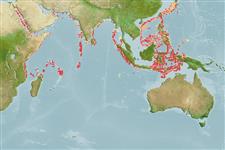Environment: milieu / climate zone / depth range / distribution range
Ekologi
marina bentopelagisk; djupintervall 250 - 350 m (Ref. 6181). Deep-water; 31°N - 14°S, 32°E - 139°E (Ref. 6181)
Western Indian Ocean: Red Sea and west coast of India. Western Pacific: Timor Sea. This species has long been synonymized with Trichiurus lepturus.
Size / Vikt / Age
Maturity: Lm ? range ? - ? cm
Max length : 42.4 cm TL hane/ej könsbestämd; (Ref. 6181); common length : 23.0 cm TL hane/ej könsbestämd; (Ref. 6181)
Taggstrålar i ryggfenan (totalt) : 3; Mjukstrålar i ryggfenan (totalt) : 106 - 116; Mjukstrålar i analfenan: 80. Body extremely elongate, compressed and tapering to a point. Mouth very large with a small dermal process at the tip of each jaw. Pelvic and caudal fins absent. Lateral line originating at the upper margin of the gill cover, running obliquely to behind the tip of the pectoral fins, then parallel to the ventral contour of the body. Fresh specimens are pearl white and slightly dusky dorsally; the margins of the dorsal and anal fins dusky in formalin.
Found in deep waters off Kerala and Tamil Nadu, India. Feeds on deep water shrimps and small fishes like myctophids and gonostomatids. Caught with deep water trawls mixed together with other commercially important fish as bycatch.
Life cycle and mating behavior
Könsmognad | Reproduktion | Lek | Ägg | Fecundity | Larver
Nakamura, I. and N.V. Parin, 1993. FAO Species Catalogue. Vol. 15. Snake mackerels and cutlassfishes of the world (families Gempylidae and Trichiuridae). An annotated and illustrated catalogue of the snake mackerels, snoeks, escolars, gemfishes, sackfishes, domine, oilfish, cutlassfishes,. scabbardfishes, hairtails, and frostfishes known to date. FAO Fish. Synop. 125(15):136 p. (Ref. 6181)
IUCN Red List Status (Ref. 130435: Version 2024-2)
Threat to humans
Harmless
Human uses
Fiskeri: saknar intresse
Verktyg
Special reports
Download XML
Internet-källor
Estimates based on models
Preferred temperature (Ref.
123201): 11 - 21.8, mean 12.2 °C (based on 49 cells).
Phylogenetic diversity index (Ref.
82804): PD
50 = 0.5020 [Uniqueness, from 0.5 = low to 2.0 = high].
Bayesian length-weight: a=0.00191 (0.00078 - 0.00466), b=3.12 (2.91 - 3.33), in cm total length, based on LWR estimates for this (Sub)family-body shape (Ref.
93245).
Trofisk nivå (Ref.
69278): 4.2 ±0.73 se; based on food items.
Resiliens (Ref.
120179): Låg, lägsta populationsfördubblingstid 4,5-14 år (Assuming tmax>10).
Fishing Vulnerability (Ref.
59153): Low to moderate vulnerability (32 of 100).
Nutrients (Ref.
124155): Calcium = 167 [42, 435] mg/100g; Iron = 0.939 [0.262, 3.001] mg/100g; Protein = 17.7 [15.9, 19.6] %; Omega3 = 0.285 [0.122, 0.695] g/100g; Selenium = 57.5 [16.1, 220.8] μg/100g; VitaminA = 5.47 [0.58, 46.73] μg/100g; Zinc = 0.834 [0.382, 1.501] mg/100g (wet weight);
